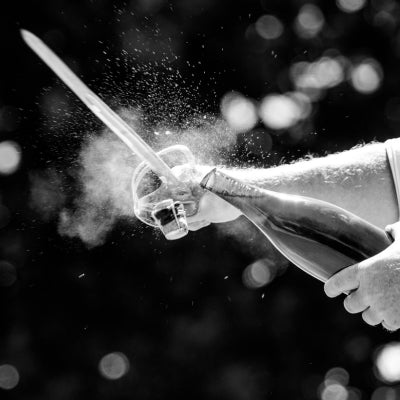
Getting to Know Champagne
Champagne is a wine rich in mystique—the process, the history, the big names, and the sheer beauty of bubbles in your glass gives Champagne an aura of effervescent luxury.
But how much do you know about it, really? If you buy premium wine you are likely familiar with the fact that it must come from the region of Champagne in France, but the more you know about it, from the terroir, to the process, to what makes the big names so special, the more you’ll relish popping the cork on your prized bottles.
Over the next few blog entries, we will dig a little deeper, and burst the bubble on what makes Champagne so special.
PART ONE: The Process
How do you get those bubbles? Well, the process starts with basic winemaking. Chardonnay, Pinot Noir, and Pinot Meunier are pressed very gently, so as not to extract the phenolics that come from their skins. This was traditionally done in a press designed specifically for Champagne called the Coquard press although now there are other authorized presses. The juice is separated into the fractions, the first 2,050 liters per 4000 kilos of grapes are called the cuvée, and create the finest wines. The next 500 liters are the taille. The taille has less acid and is more typically used for the wines that are non-vintage (NV). Fermentation then takes place, typically in stainless steel but some producers may choose for it to be in large neutral oak barrels called foudre. Sometime malolactic conversion is carried out to soften acid, but this is a stylistic choice of the winemaker. The alcohol level at this point is around 11% abv, and may not exceed 13%, as the secondary fermentation will raise the level more.
The next step is to create the blend, in a process called assemblage. Because a Champagne house typically wishes their NV wines to be consistent in style from year to year, many parcels of wines are retained each year. If a rosé wine is desired, the blend takes place at this time too. Unlike still rosé wines, which are usually made of from red grapes that have not spent long on their skins, a rosé Champagne is usually the blend of a red wine and a white one, although sometimes it is made in the same manner as a still rosé wine.
The blends are bottled and the “liqueur de tirage”, which includes yeast and sugar is added to create a secondary fermentation. The secondary fermentation raises the level of alcohol about 1.5%. Because the bottles are sealed, the carbon dioxide, another byproduct of fermentation, is trapped dissolved in the wine. It is that all-important captured carbon dioxide that will create bubbles when the wine is eventually opened.
Next, the wines will spend time aging “sur lie”, or on the dead yeast cells left in the bottle. It is the lees, that as they break down to create the classic flavors we associate with Champagne such as brioche and toast. A non-vintage Champagne must remain on its lees at least 12 months and may not be released for at least fifteen. A vintage Champagne will spend at least 3 years in the cellar, 12 months of which must be on the lees although in practice many spend far longer.
The next step after aging sur lie is the process of getting the dead yeast cells out of the bottle. This happens in a practice called riddling in which bottles are slowly rotated as they are gradually turned neck down, allowing the sediment to accumulate in the neck. This used to be done by hand, and takes weeks if not months to accomplish but there is now a device called a gyropalate that accomplishes this must faster. The necks of the bottles are then frozen and the sediment is expelled from the bottle. At this point, a dosage, a mixture of wine and sugar may be added before the cork and cage being attached.
It is a lengthy and complicated process, but open a bottle of prestige cuvee and you will understand why winemakers are willing to undertake it!



